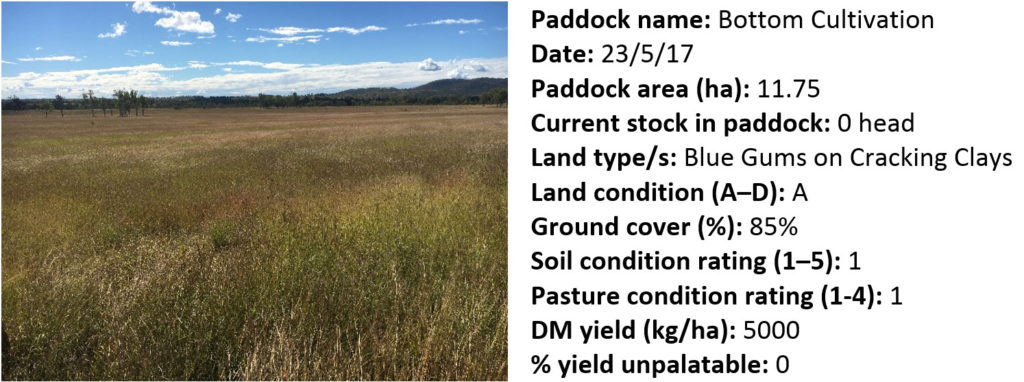Forage budgeting – a valuable tool for pasture management at Brian Pastures
Forage budgeting is the process of calculating forage supply and livestock demand over a set period. Knowing how much forage is available assists us to make informed and timely grazing management decisions, ensure there is enough residual pasture at the end of the grazing period, and help use available pasture more efficiently.
In my role as a technical officer based at Brian Pastures Research Facility, it is critical to understand how much forage is available for grazing from the end of the growing season (usually May) until the start of the next likely growing season. Most cattle on the research facility are involved in projects, so the capacity to destock during dry periods is often limited. We do forage budgets on a paddock by paddock basis taking into account; paddock area, land types, land condition, soil and pasture condition, pasture yield (kg DM/ha), and percent of unpalatable species.
To estimate pasture yield we use photo standards designed for that land type and take quadrat cuts of the dominant grass species to calibrate our estimates. A photo is taken annually in each paddock so we can compare any changes in land, pasture and soil condition over time. Below is an example of the information we collect during a forage budget.

These measurements are critical to our decision making, and can answer a number of important questions such as; how many grazing days do we have for our current herd? How do we need to adjust our herd numbers to ensure this paddock will last for a set period? We do simple calculations using Excel that take into account target residual pasture to maintain adequate ground cover. See the article “Set your stocking rates for winter: a simple assessment” to see how to do your own calculations. In the above example, this paddock could carry 40 head of breeders (60 Adult Equivalents) for approximately 48 days before the target pasture residual of 1500 kg DM/ha is reached.
This information is extremely valuable to determine stocking rates and length of grazing in each paddock, planning paddock grazing and spelling rotations, and identifying early if further measures need to be taken to ensure target residual pasture will not be compromised at the end of the dry season to maintain land condition.
The time it takes to conduct a forage budget each year is well worthwhile. It has proven to be a valuable grazing management decision tool which is critical in an industry needing to manage such variable seasons.
To find out more, attending a one-day Stocktake workshop is highly recommended.
Jo Conroy, DAF, Brian Pastures Research Facility, Gayndah
0417 139 295 or joanne.conroy@dpi.qld.gov.au